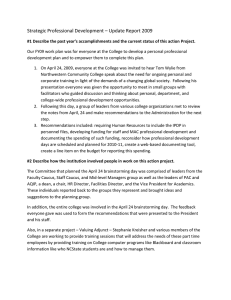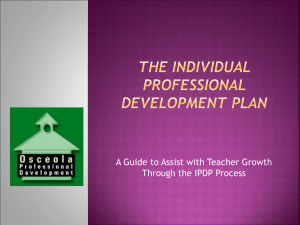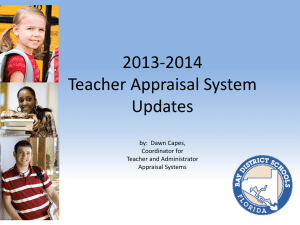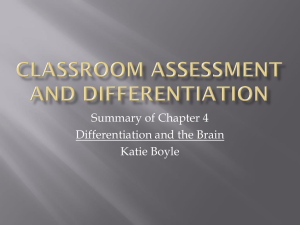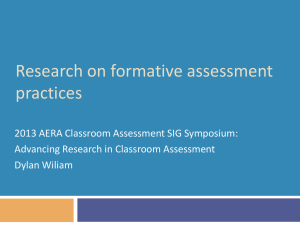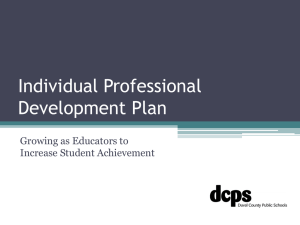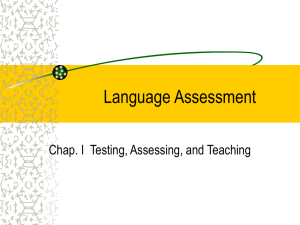Formative Evaluation - Bay District Schools
advertisement
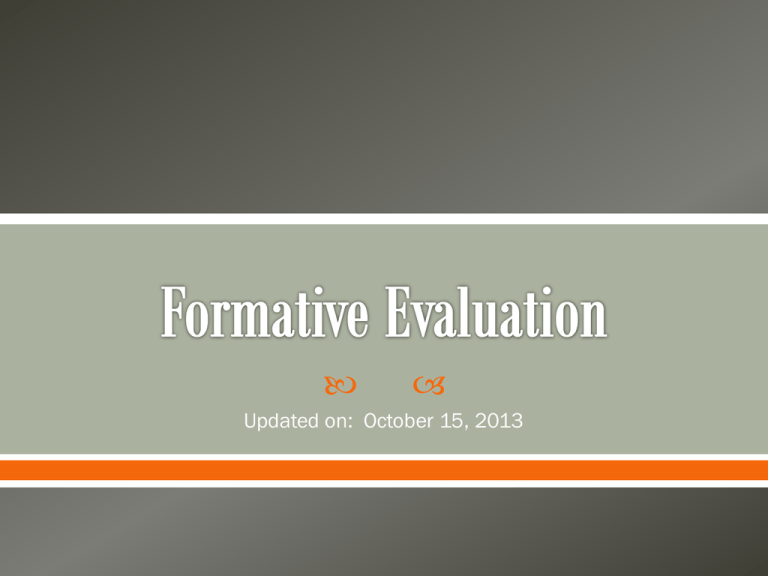
Updated on: October 15, 2013 Category 1 Score and 2 teachers does not compute into the Summative Evaluation Designed to give feedback on Instructional Practice and IPDP status Informs professional development and support needed Provided to state and teacher will receive notification from the state 3 days in advance of Observation Prior to November 22 Within 10 days of observation Prior to December 14th Pre-conference with administrator Observation Post-conference with administrator Mid-Year Conference Review collected evidence, artifacts and data regarding the ten Key Components of the Framework for Teaching and determine formative Instructional Practices rating Review teacher’s progress relative to the IPDP and assign a formative IPDP rating Assign a formative evaluation overall rating based on the Formative Evaluation Rubric Readdress the teacher’s IPDP as appropriate and as needed See Project 8 website for Detail and Yearly Calendars: http://www.bay.k12.fl.us/rttt/Project8.aspx Ten Key Components o A portion of the rubric you used to self-assess o Taken from Charlotte Danielson’s research Observation Cycle o Pre-Conference, Observation, Post-Conference Collection of evidence and artifacts o Consistency and quality over time o No number • Most evidence will demonstrate multiple components • Consistency and quality over time • Vary based on type of evidence and what administrative team already collects o Administrative team will provide guidance Mid-year conference o Evaluation of Instructional Practice To which part of your curriculum does this lesson relate? (1e) How does this learning fit in the sequence of learning for this class? (1a, 1c, 1e) Briefly describe the students in this class, including those with special needs. (1b) What are your learning outcomes for this lesson? What do you want the students to understand? (1c) How will you engage the students in the learning? What will you do? What will the students do? Will the students work in groups, or individually, or as a large group? Provide any worksheets or other materials the students will be using. (1d, 1e) How will you differentiate instruction for different individuals or groups of students in the class? (1b, 1d) How and when will you know whether the students have learned what you intend? (1f) Is there anything that you would like me to specifically observe during the lesson? In general, how successful was the lesson? Did the students learn what you intended for them to learn? How do you know? (3d, 4a) If you have samples of student work, what do they reveal about the students’ levels of engagement and understanding? Do they suggest modifications in how you might teach this lesson in the future? (3d, 3c) Comment on your classroom procedures, student conduct, and your use of physical space. To what extent did these contribute to student learning? (2c, 2d, 2e) Did you depart from your plan? If so, how and why? (3e) Comment on different aspects of your instructional delivery (e.g., activities, grouping of students, materials, and resources). To what extent were they effective? (2c, 3c, 3e, 1d, 1e) If you had an opportunity to teach this lesson again to the same group of students, what would you do differently? (4a) Consider different aspects of your planning and execution of the lesson in light of the domains and components on the following pages. Determine evidence, if any, for each of the components, and what that evidence demonstrates about your level of performance. 10 Key Components Pre-conference, observation, post-conference and other evidence Basic information Enhancing Professional Practice by Charlotte Danielson Evidence added to based on school’s strengths, initiatives, etc. Complete rubric available on the RTTT Website: http://www.bay.k12.fl.us/rttt/Project8.aspx Background Information: Based on standards and course descriptions Able to be assessed Includes needs of group as well as individual students Clear to stakeholders in language appropriate to the learner Evidence: Pre-conference questions Other evidence: Lesson plans Background Information: Alignment to standards and correspondence cognitive complexity Formative and summative Groups and individuals Rubrics Authentic, real-world application Exact items not provided to students; similar items are presented for student review Evidence: Pre-conference questions Other evidence: Lesson Plans Background Information: Teacher-student and student-student interactions Teacher cares enough to insist on high standards of work and conduct Student understands there are ground rules and standards of conduct or routines that may be different than those at home Evidence: Classroom observation o o o o Words and actions that show teacher-student and student-student interactions. How does the teacher speak to students and allow them to speak to each other? How does the teacher respond to off-task behavior and redirect behavior? Does the teacher greet students as they enter the room and ask questions or show concern about things beyond the classroom? Other evidence o Lesson Plans showing how the environment was created or how the teacher allowed students to assist in any procedural creation that is posted in the room. o Handouts? Posters created by students? Background Information Students and teachers o Engaged in pursuits of value with cognitive complexity o Take pride in work and give best efforts o High energy and high expectations Evidence Classroom Observation o Look of the room –is student work displayed, for example? What is the nature of interactions and tone of conversations from teacher-student and student-student? Other evidence o Lesson plans with instructional outcomes and activities demonstrating high expectations o Conversations reveal they value learning and hard work Background Information: Standards of conduct are clear, communicated to students, and posted in the classroom Monitoring is subtle and preventative-the teacher goes to stand next to off-task students Student behavior indicates standards established at the beginning of the year and have been maintained consistently Evidence: Classroom Observation and Post-Observation Conference Other evidence o Lesson plans showing how standards were developed or posters of the classroom standards (rules, procedures, etc.). o Students themselves explain the agreed-upon standards of conduct Kagan, Fred Jones, Harry Wong, RtI strategies Background Information: Mix of cognitively complex questions related to lesson objectives ALL students involved in questioning and discussion- no single student dominates and teacher calls on those who don’t initially volunteer Students initiate higher order questions o Note: Developmentally appropriate. IB or AICE versus ESE-Autistic class; Kindergarten versus 12th grade. All students should be asked questions that are cognitively complex. Evidence Classroom observation o A class session demonstrating questioning and discussion (CRISS strategies ) Other evidence o Planning for cognitively complex questions; training students to answer complex questions or participating in a discussion o Lesson plans, student samples, handouts used with students, or procedural information placed in the room that students reference during discussions Background Information: Clear structure and objectives ALL students mentally involved, actively participate, and make genuine contributions Students have choice task completion- activities are differentiated for learners and students are grouped accordingly Evidence: Classroom observation and Post-Conference o Students given an opportunity to engage with the material Other evidence: o Lesson plans showing how the teacher planned for student engagement, student samples and classroom evidence of differentiated instruction CRISS strategies, Reading Framework strategies such as guided reading, learning stations, etc. can use these as evidence of student engagement Background Information: Reflection is the mark of a true professional Able to assess effectiveness of work and can take steps to improve Teaching, given its complexity, can never be perfect No matter how good a lesson, it can always be improved This is not to suggest a lesson is of poor quality and must be fixed, but because quality teaching is so hard, some aspect can always be improved Evidence: Post-conference questions Additional discussion will help in understanding how the teacher reflects and what they do with that knowledge Other evidence: o Lesson study or any other reflection activities Background Information: Records are an important aspect of teaching Informs student-teacher interactions and enables teachers to respond to individual needs Aware of which assignments have been completed and which are still outstanding Students contribute to design and implementation (where appropriate), because of exposure to many different systems over the course of their educational career Evidence: Post Conference Other Evidence: Use of online gradebook, RtI folders, assessment results, and record keeping systems of non-instructional activities (such as field trip forms, lunch records, etc.) Background Information: Most parents care deeply about the progress of their child and appreciate meaningful participation in the process Just as students should not be surprised about an assessment or the procedures of the class, parents also need information that will not make the teacher’s approach to learning a surprise Evidence: Post-Conference Other evidence: Written information, web site, Open House information, regular newsletters, phone calls, formalized procedures (progress reports, report cards), notes, emails Pre-conference, Observation, Post-conference Review additional evidence Balance of information Instructional Practice 70% Levels 0 1 Ratings Unsatisfactory Developing All teachers Greater than or equal to 50% at Level 1 and/or Level 0 If not meeting HE, E or U, then Developing 2 3 Effective Highly Effective At least 75% at Level 3 and/or Level 2 and 0% AT Level 0 At least 80% at Level 3 and 0% at Level 1 and/or Level 0 Mid-year conference IPDP review Review IPDP and assign a score to each section of the IPDP o Student Baseline Data o Needs-Based Question o Student Goal o Professional Development Objectives o Professional Development Training/Activities o Classroom Implementation IPDP 30% Levels 0 1 2 3 Ratings Used for Each IPDP Component All categories Unsatisfactory Developing Effective Highly Effective 1 or more rated 0 (Unsatisfactory) 1 or more rated 1 (Developing) If not meeting HE, D or U, Effective 6/6 rated 3 (Highly Effective) Instructional Practice Level______X 70%=___________ IPDP Level_______X 30%=______________ Total Evaluation Level_______________ Levels Ratings Used for Each Section All Categories 0 Unsatisfactory Less than or equal to .75 1 Developing Greater than .75 2 Effective 3 Highly Effective Greater than or equal to 1.5 Greater than or equal to 2.40 The results of the Formative Evaluation score will be used to guide category 1 and 2 teacher professional development and support The Formative Evaluation score does NOT compute into the Summative Evaluation score Allows the Category 1 and 2 teacher to know where they need to improve PRIOR to the summative evaluation This concludes the review of the Formative Evaluation Please remember all materials are placed on the Race to the Top website: http://www.bay.k12.fl.us/rttt/Project8.aspx Thank you
